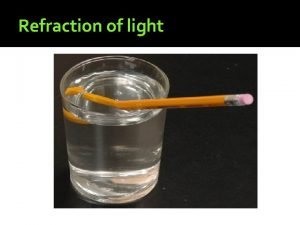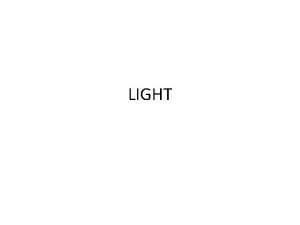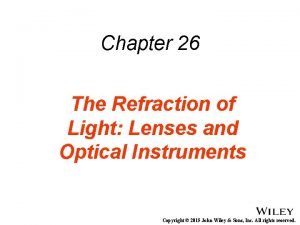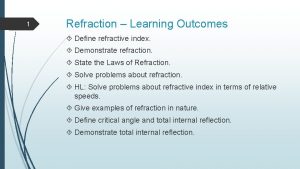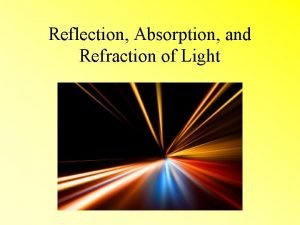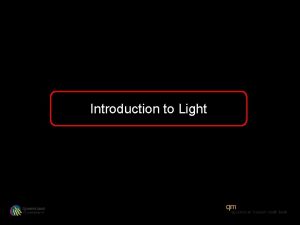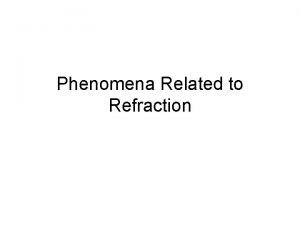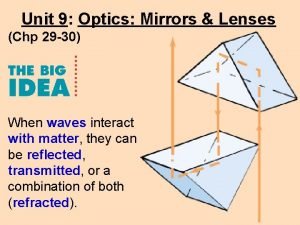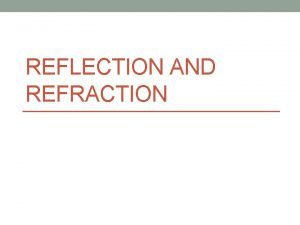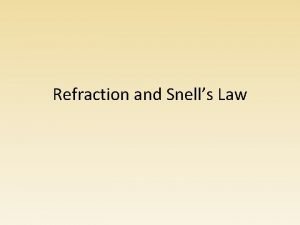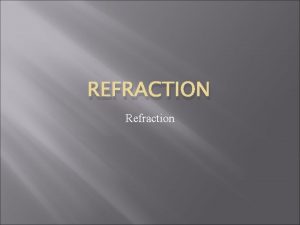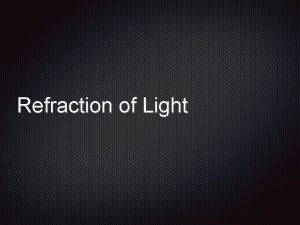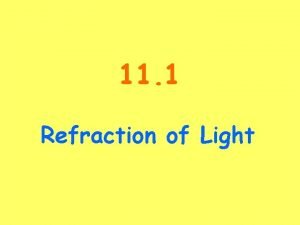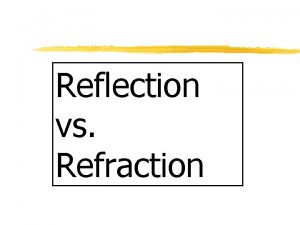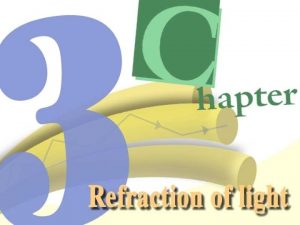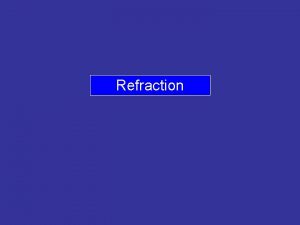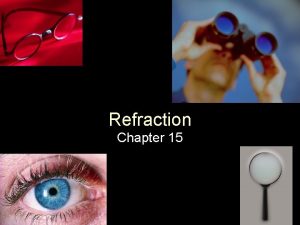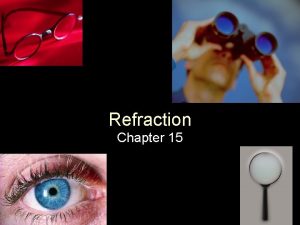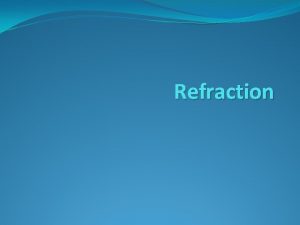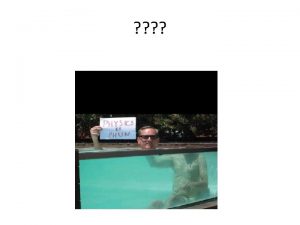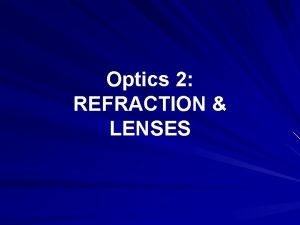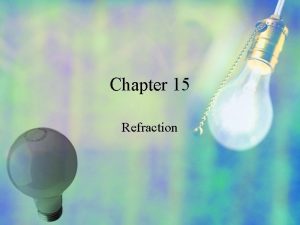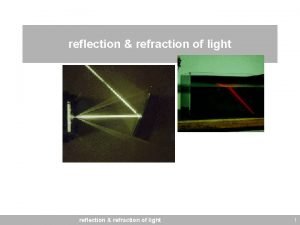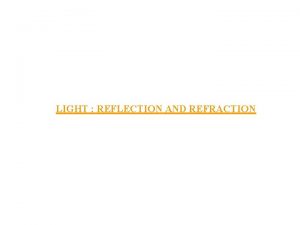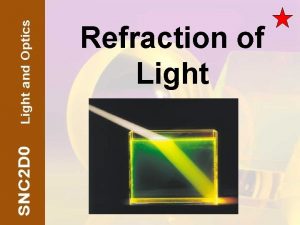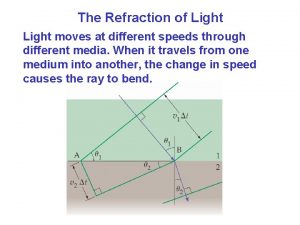Refraction Refraction When light moves from one medium



















- Slides: 19

Refraction

Refraction • When light moves from one medium to another the path of the light changes • at the boundary between the substances. This change in path is known as refraction.

The transparent block Less dense air more dense transparent block The normal ray A ray at right angles to the boundary is called a normal. The path of this ray is unchanged

Simple investigation Place a transparent block on graph paper, at right angles to a normal line drawn on the paper Draw around the block Shine a ray through the block at 300. Trace the ray to the block by marling two points on it and trace it as it emerges from the block in the same way. Construct a straight ray through the block by joining the ray where it enters and emerges from the block. Repeat for two other angles. What do you observe?

A small amount of reflected light from the boundary Emergent ray Path of refracted light Notice that the ray emerges parallel to the undeviated ray. Incident ray

As the ray moves from the less dense to the more dense medium it is deviated towards the normal. (This is another way of saying that the angle of incidence is larger than the angle of refraction) Angle of refraction (r) Angle of incidence (i)

As you would expect the situation is the exact reverse as the ray emerges from the block Angle of refraction (r) Angle of incidence (i) As the ray emerges from the block it is passing from a more dense medium into a less dense medium. The light bends away from the normal (i. e. the angle of incidence is less than the angle of refracttion)

Huygens The explanation for what is happening in refraction is attributed to Huygens. He suggested that the speed of light changes as it passes from one medium into another Paved yard 1625 -1689 He compared the effect to what happens to a column of soldiers as they move into more difficult terrain. As each soldier slows the column is forced to turn Sand

Less dense medium Notice that the wavelength of the light must change as it enters the second medium The waves slow down when they reach the More dense medium

The change in speed as the wave enters the new medium forces a change in direction Less dense More dense

• The speed of light is only constant in a vacuum. Its value changes (is reduced) when it passes through any other medium • The wavelength (λ)of the light is reduced in a more dense medium. • The frequency must remain the same (if the number of waves passing in one second were to reduce the light waves would bunch up!)

How This Affects The Wave Equation For medium number 1 For medium number 2 This equation shows you that the wavelength and the speed of light from medium to medium can change without affecting the frequency of the light.

The laws of refraction Angle of incidence (θ 1) Angle of refraction (θ 2) 1. The incident ray the refracted ray and the normal are all in the same plane Snell’s Law 2. At the boundary between the two substances the ratio of the sine of the angle of incidence to the sine of the angle of refraction is a constant.

The laws of refraction Angle of incidence (θ 1) Angle of refraction This constant is known as the refractive index (θ 2) of medium 2 with respect to medium 1 It can also be shown that 1 n 2 = velocity of light in medium 1 velocity of light in medium 2

Absolute refractive index We measure the absolute refractive ability of a substance by how much the light is slowed down compared to the speed of light in a vacuum. This is called the absolute refractive index (n) of the substance n= velocity of light in a vacuum velocity of light in medium 1

vacuum The refractive index of medium 1 is the velocity of light in a vacuum / the velocity of light in medium 1 The waves slow down when they reach the More dense medium 1

Refractive index n 1 is the absolute refractive index of the medium 1. For every medium n is different and so we use a subscript to distinguish between different media medium 1…. absolute refractive index n 1 medium 2 …. absolute refractive index n 2 etc medium 1 medium 2 1 n 2 = velocity of light in medium 1=c 1 velocity of light in medium 2 c 2

Refractive index 1 Snell’s Law 2 substituting equation 2 into 1 This is Snell’s law in terms of absolute refractive indices

medium Absolute Refractive index air 1. 0008 water 1. 330 glass 1. 510 ruby 1. 760 diamond 2. 417 It can be seen from the table that the refractive index of air is just about the same as the refractive index of a vacuum (1. 0000) and it is the same value for our purposes
 Light light light chapter 23
Light light light chapter 23 Light light light chapter 22
Light light light chapter 22 Light light light chapter 22
Light light light chapter 22 Hot and cool media
Hot and cool media Vydj
Vydj Cause of refraction of light
Cause of refraction of light A lens that curve outwards and are fatter in the middle
A lens that curve outwards and are fatter in the middle Refraction of light in lenses
Refraction of light in lenses Laws of refraction
Laws of refraction Reflection refraction absorption transmission
Reflection refraction absorption transmission Introduction of light
Introduction of light Phenomena related to refraction of light
Phenomena related to refraction of light Refraction of light
Refraction of light Refraction of light
Refraction of light Refraction of light
Refraction of light Refraction of light meaning
Refraction of light meaning 071-com-0815
071-com-0815 A ray of light travels from an optical denser
A ray of light travels from an optical denser A business that gathers raw products in their natural state
A business that gathers raw products in their natural state One god one empire one emperor
One god one empire one emperor





